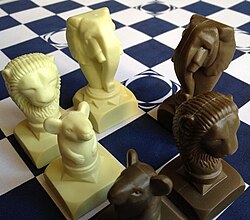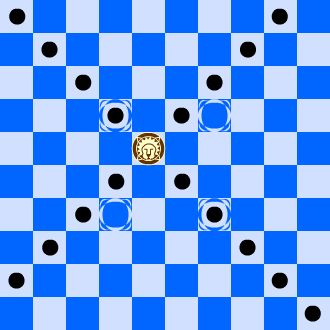Arimaa is a two-player strategy board game that was designed to be playable with a standard chess set and difficult for computers while still being easy to learn and fun to play for humans. It was invented between 1997 and 2002 by Omar Syed, an Indian-American computer engineer trained in artificial intelligence. Syed was inspired by Garry Kasparov's defeat at the hands of the chess computer Deep Blue to design a new game which could be played with a standard chess set, would be difficult for computers to play well, but would have rules simple enough for his then four-year-old son Aamir to understand.
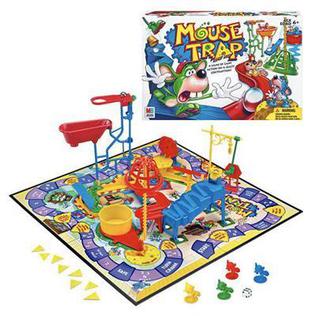
Mouse Trap is a board game first published by Ideal in 1963 for two to four players. It is one of the first mass-produced three-dimensional board games. Players at first cooperate to build a working mouse trap in the style of a Rube Goldberg machine. Then, players turn against each other to trap opponents' mouse-shaped game pieces.
Fox games are a category of asymmetric board games for two players, where one player is the fox and tries to eat the geese / sheep, and the opposing player directs the geese/sheep and attempts to trap the fox, or reach a destination on the board. In another variant, fox and hounds, the fox merely tries to evade the hounds. There are several versions known:

Sittuyin, also known as Burmese chess, is a strategy board game created in Myanmar. It is a direct offspring of the Indian game of chaturanga, which arrived in Myanmar in the 8th century thus it is part of the same family of games such as chess, and shogi. Sit is the modern Burmese word for "army" or "war"; the word sittuyin can be translated as "representation of the four characteristics of army"—chariot, elephant, cavalry and infantry.

Jungle or dou shou qi is a modern Chinese board game with an obscure history. A British version known as "Jungle King" was sold in the 1960s by the John Waddington company. The game is played on a 7×9 board and is popular with children in the Far East.
Tamerlane chess is a medieval chess variant. Like modern chess, it is derived from shatranj. It was developed in Central Asia during the reign of Emperor Timur, and its invention is also attributed to him. Because Tamerlane chess is a larger variant of chaturanga, it is also called Shatranj Al-Kabir, as opposed to Shatranj as-saghir. Although the game is similar to modern chess, it is distinctive in that there are varieties of pawn, each of which promotes in its own way.

Chu shogi is a strategy board game native to Japan. It is similar to modern shogi in its rules and gameplay. Its name means "mid-sized shogi", from a time when there were three sizes of shogi variants that were regularly being played. Chu shogi seems to have been developed in the early 14th century as a derivative of dai shogi. There are earlier references, but it is not clear that they refer to the game as we now know it.
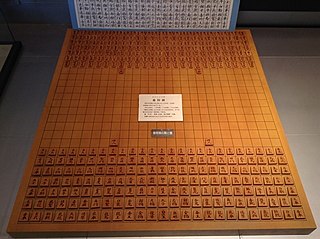
Tai shogi is a large board variant of shogi. The game dates to the 15th century and is based on earlier large-board shogi games. Before the discovery of taikyoku shogi in 1997, tai shogi was believed to be the largest playable chess variant, if not board game, ever. One game may be played over several long sessions and require each player to make over a thousand moves. It was never a popular game; indeed, a single production of six game sets in the early 17th century was a notable event.

Chaturaji is a four-player chess-like game. It was first described in detail c. 1030 by Al-Biruni in his book India. Originally, this was a game of chance: the pieces to be moved were decided by rolling two dice. A diceless variant of the game was still played in India at the close of the 19th century.
Shō shōgi is a 16th-century form of shogi, and the immediate predecessor of the modern game. It was played on a 9×9 board with the same setup as in modern shogi, except that an extra piece stood in front of the king: a 'drunk elephant' that promoted into a prince, which is effectively a second king. While 9×9 may not seem 'small', it was smaller than the other shogi variants prevalent at the time, which were the 12×12 chu shogi and 15×15 dai shogi. According to the Sho Shōgi Zushiki, the drunk elephant was eliminated by the Emperor Go-Nara, and it is assumed that the drop rule was introduced at about the same time, giving rise to shogi as we know it today.
Dai shogi or Kamakura dai shogi (鎌倉大将棋) is a board game native to Japan. It derived from Heian era shogi, and is similar to standard shogi in its rules and game play. Dai shogi is only one of several large board shogi variants. Its name means large shogi, from a time when there were three sizes of shogi games. Early versions of dai shogi can be traced back to the Kamakura period, from about AD 1230. It was the historical basis for the later, much more popular variant chu shogi, which shrinks the board and removes the weakest pieces.

Tenjiku shogi is a large-board variant of shogi. The game dates back to the 15th or 16th century and was based on the earlier chu shogi, which itself was based on dai shogi.
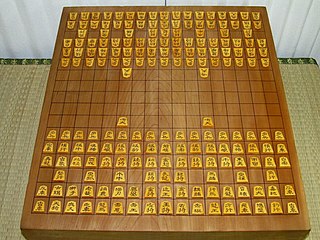
Dai dai shōgi is a large board variant of shogi. The game dates back to the 15th century and is based on the earlier dai shogi. Apart from its size, the major difference is in the range of the pieces and the "promotion by capture" rule. It is the smallest board variant to use this rule.
Tiger and buffaloes is a two-player abstract strategy board game from Myanmar. It belongs to the hunt game family. The board is a 4x4 square grid, where pieces are placed on the intersection points and move along the lines. It is one of the smallest hunt games. Three tigers are going up against eleven buffaloes. The tigers attempt to capture as many of the buffaloes by the short leap as in draughts or alquerque. The buffaloes attempt to hem in the tigers.
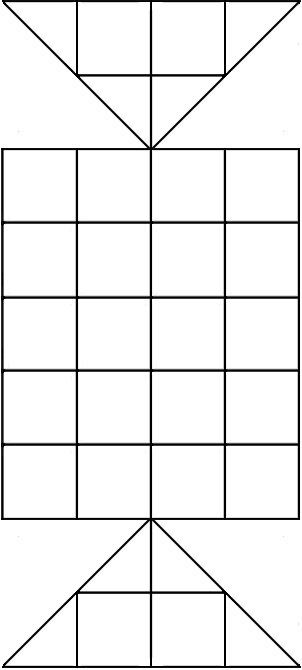
Astar is a two-player abstract strategy board game from Kyrgyzstan. It is a game similar to draughts and Alquerque as players hop over one another's pieces when capturing. However, unlike draughts and Alquerqe, Astar is played on 5×6 square grid with two triangular boards attached on two opposite sides of the grid. The board somewhat resembles those of kotu ellima, sixteen soldiers, and peralikatuma, all of which are games related to astar. However, these three games use an expanded alquerque board with a 5×5 square grid with diagonal lines. Astar uses a 5×6 grid with no diagonal lines.

Dōbutsu shōgi is a small shogi variant for young children. It was invented by women's professional shogi player Madoka Kitao, partially to attract young girls to the game. It is played on a 3×4 board and generally follows the rules of standard shogi, including drops, except that pieces can only move one square at a time, and the king reaching the enemy camp as an additional way to win the game.
The fictional universe of the Discworld novels by Terry Pratchett features a number of invented games, some of which have gone on to spawn real-world variants.

Congo is a chess variant invented by Demian Freeling in 1982 when he was nearly 8 years old. His father encouraged him to design a variant using a 7×7 gameboard. Demian was already familiar with chess and xiangqi, and the result blends some features from both. Congo became the second-most popular chess variant at the Fanaat games club in Enschede, the Netherlands.
This glossary of board games explains commonly used terms in board games, in alphabetical order. For a list of board games, see List of board games; for terms specific to chess, see Glossary of chess; for terms specific to chess problems, see Glossary of chess problems.
